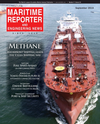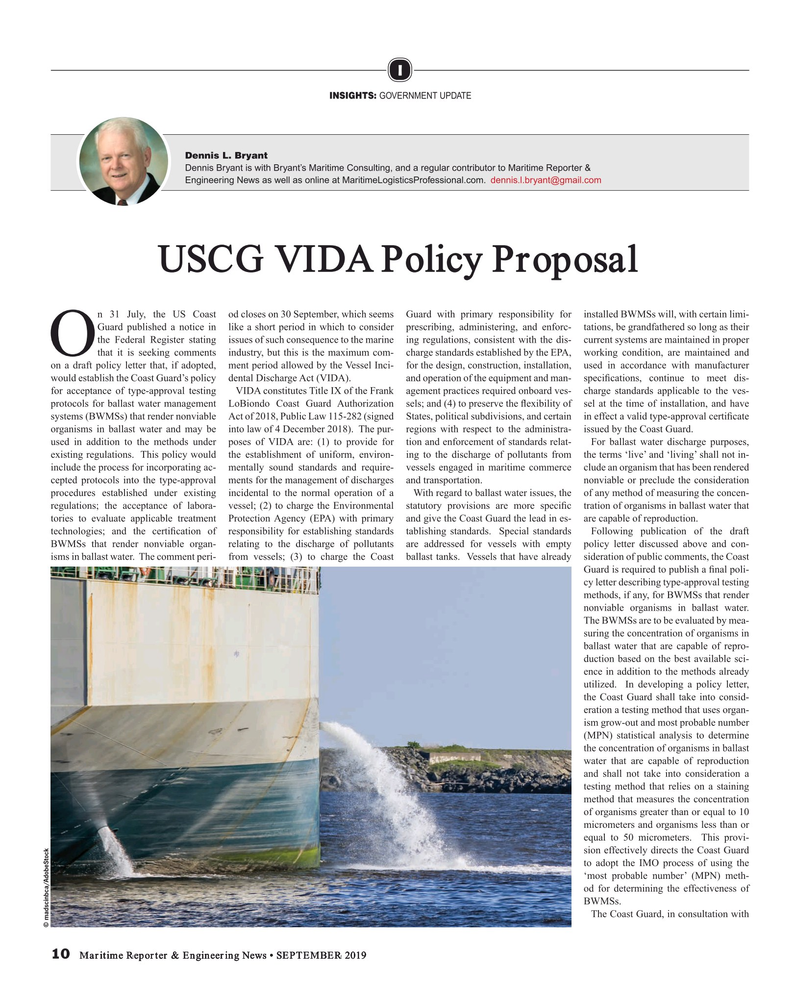
Page 10: of Maritime Reporter Magazine (September 2019)
Satellite Communications
Read this page in Pdf, Flash or Html5 edition of September 2019 Maritime Reporter Magazine
I
INSIGHTS: GOVERNMENT UPDATE
Dennis L. Bryant
Dennis Bryant is with Bryant’s Maritime Consulting, and a regular contributor to Maritime Reporter &
Engineering News as well as online at MaritimeLogisticsProfessional.com. [email protected]
USCG VIDA Policy Proposal n 31 July, the US Coast od closes on 30 September, which seems Guard with primary responsibility for installed BWMSs will, with certain limi-
Guard published a notice in like a short period in which to consider prescribing, administering, and enforc- tations, be grandfathered so long as their the Federal Register stating issues of such consequence to the marine ing regulations, consistent with the dis- current systems are maintained in proper
Othat it is seeking comments industry, but this is the maximum com- charge standards established by the EPA, working condition, are maintained and on a draft policy letter that, if adopted, ment period allowed by the Vessel Inci- for the design, construction, installation, used in accordance with manufacturer would establish the Coast Guard’s policy dental Discharge Act (VIDA). and operation of the equipment and man- speci? cations, continue to meet dis- for acceptance of type-approval testing VIDA constitutes Title IX of the Frank agement practices required onboard ves- charge standards applicable to the ves- protocols for ballast water management LoBiondo Coast Guard Authorization sels; and (4) to preserve the ? exibility of sel at the time of installation, and have systems (BWMSs) that render nonviable Act of 2018, Public Law 115-282 (signed States, political subdivisions, and certain in effect a valid type-approval certi? cate organisms in ballast water and may be into law of 4 December 2018). The pur- regions with respect to the administra- issued by the Coast Guard. used in addition to the methods under poses of VIDA are: (1) to provide for tion and enforcement of standards relat- For ballast water discharge purposes, existing regulations. This policy would the establishment of uniform, environ- ing to the discharge of pollutants from the terms ‘live’ and ‘living’ shall not in- include the process for incorporating ac- mentally sound standards and require- vessels engaged in maritime commerce clude an organism that has been rendered cepted protocols into the type-approval ments for the management of discharges and transportation. nonviable or preclude the consideration procedures established under existing incidental to the normal operation of a With regard to ballast water issues, the of any method of measuring the concen- regulations; the acceptance of labora- vessel; (2) to charge the Environmental statutory provisions are more speci? c tration of organisms in ballast water that tories to evaluate applicable treatment Protection Agency (EPA) with primary and give the Coast Guard the lead in es- are capable of reproduction. technologies; and the certi? cation of responsibility for establishing standards tablishing standards. Special standards Following publication of the draft
BWMSs that render nonviable organ- relating to the discharge of pollutants are addressed for vessels with empty policy letter discussed above and con- isms in ballast water. The comment peri- from vessels; (3) to charge the Coast ballast tanks. Vessels that have already sideration of public comments, the Coast
Guard is required to publish a ? nal poli- cy letter describing type-approval testing methods, if any, for BWMSs that render nonviable organisms in ballast water.
The BWMSs are to be evaluated by mea- suring the concentration of organisms in ballast water that are capable of repro- duction based on the best available sci- ence in addition to the methods already utilized. In developing a policy letter, the Coast Guard shall take into consid- eration a testing method that uses organ- ism grow-out and most probable number (MPN) statistical analysis to determine the concentration of organisms in ballast water that are capable of reproduction and shall not take into consideration a testing method that relies on a staining method that measures the concentration of organisms greater than or equal to 10 micrometers and organisms less than or equal to 50 micrometers. This provi- sion effectively directs the Coast Guard to adopt the IMO process of using the ‘most probable number’ (MPN) meth- od for determining the effectiveness of
BWMSs.
The Coast Guard, in consultation with © madscinbca/AdobeStock 10 Maritime Reporter & Engineering News • SEPTEMBER 2019
MR #9 (10-17).indd 10 MR #9 (10-17).indd 10 9/11/2019 9:17:39 AM9/11/2019 9:17:39 AM

 9
9

 11
11
